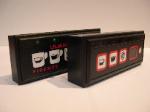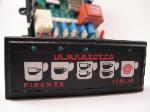The Espresso Machine Restoration site
A non-commercial site for those interested in espresso equipment repair and restoration.

Marzocco control unit do I have?
to the Gicar control units. And to make it even more confusing they have been given names rather than serial
numbers so you have no idea which is which.
Anyway, wonder no more. Here are the "brains" and keypads explained.
1. The Black box, aka "brain" aka main control unit.
2. The keypads, aka "button box".
3. Ribbon cables.
What do the components as a whole do?
The control units are what make a semi-automatic espresso machine an automatic semi-automatic machine.
They allow the shots to be measured accurately by volume with the help of the flowmeters. The shot is started by
the barista but the control unit will stop the shot automatically when the pre-defined volume of water has passed
through the flowmeter.
Besides controlling the shot volumes, the units also incorporate the water level unit for the steam boilers and
the single boiler on a HX machine. So besides controlling the pump and the 3 way solenoid valves attached to
each group they also control the pump and the solenoid that fills the steam boiler. The water level unit probe is
obviously connected to the control unit.
To recap, the controller has two functions; to control the water level in the steam boiler and to control the
volume of water that determines the shot volume.
The control unit is supplied by the 220V (or 110V) mains supply of the machine. The control box then transforms
this 220V AC into 18V AC with the transformer on the circuit board. This 18V AC is then converted to DC through
a series of diodes and finally a capacitor to filter out any remaining AC signal.
What is left is 18V DC which powers the board relays and flowmeters and 5V DC which powers the
microprocessor and logic circuits.
The unit's relays control the 220V AC for the pump and the 3 way solenoid valves for brewing operation. They
also control the pump and another 3 way solenoid used for filling of the steam boiler.
So on an automatic semi-auto machine it controls everything?
Yes and No. When you buy an AV La Marzocco machine you get the benefit of both the consistency and ease of
the volumetric dosing, but also the versatility and control of an EE machine. In reality you get the AV controls with
a completely separate EE circuit in case of malfunction, i.e. if one of the keypads dies during morning rush-hour
then you can still override with the EE rocker switches. The only exception to this is if the water level control goes
belly-up and then you will need to replace the whole unit or get it repaired. Even so you still have a manual fill
button on the steam boiler to get you through some troubling times.
Input side Output side
220V input. 220V control output to the group solenoid valves.
18V DC signal from the flowmeter(s) 220V control output to the pump for brewing (group) operation.
A ground signal from the water level probe. 220V control output for the solenoid to fill the steam boiler.
A ribbon cable from the keypads/button boxes. 220V control output to the pump for steam boiler filling.
18V DC output (to be switched) to the flowmeter.
This is the confusing issue. Certain changes have been made over the years to the control units. Current
production units has the wizard 3D5 Units. The now obsolete units are called Mask and Non-Mask. The easy way
to identify which unit you have is by checking the ribbon cables and seeing how many wires it has - count the pins
on the connectors.
The table below has a summary of the units.
Because the control unit is placed so close to the boilers, overheating has been an issue on early machines.
Sometime around the mid-1990's a cooling fan was introduced to suck in cooler air from outside the machine and
direct it onto the control unit.
The other way to do it is to move the box to underneath the machine or install some sort of metallic heat shield.
The fans do work and they solve the heat problem, but they do suck in a luck of dust!
I will say yes, but please ask first!
Email me here.







